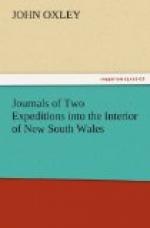The soil of these extensive plains, designated Field’s Plains, is for the most part extremely rich, as indeed might be expected, from the deposition of the quantities of vegetable matter that must take place in periods of flood. The plains are in some places even lower than the ground forming the immediate bank of the river, very soft, and difficult for loaded horses to pass over. If we had been so unfortunate as to have had a rainy season, it would have been utterly impossible to have come thus far by land. The ranges of hills are unconnected, and are rocky and barren; the swamps for the most part surrounding them. Mount Cunningham is a lofty rocky hill, about a mile and a half long, composed of granite rock, but entirely surrounded by low swampy ground.
Here we were so unfortunate as to find the barometer broken, the horse which carried the instruments having thrown his load in passing the swamps: every precaution had been taken in the packing to prevent such an accident, which was the more to be regretted, as it interrupted a chain of observations by which I hoped to ascertain the height of the country with tolerable accuracy. The last observations that were made, reduced to this place, gave us an elevation of not more than five hundred feet above the sea, or about a hundred feet lower than the country at the depot.
Since the river has been swollen, the fish have eluded us, none having been caught since yesterday morning. Two black swans were however shot on the river. Our present situation is by no means enviable: in the first place, there is every chance that the river may be lost in a multitude of branches, among those marshy flats, and farther navigation thus rendered impossible; and in the second, a rise of four feet in the river would sweep us all away, since we have not the smallest eminence to retreat to. Should the river lead through to the westward, and be afterwards joined by the branches we have passed, it may become something more interesting and encouraging: a wet or even a partially rainy season will, in my judgment, preclude us from returning by our present route, more especially if these low countries continue for any distance.
I am by no means surprised at the paucity of natives that have been seen: it would be quite impossible in wet seasons to inhabit these marshes, and equally so for them to retreat in times of flood. Their fires are universally observed near the higher grounds, and no traces of any thing like a permanent camp has hitherto been seen; but in many places on the banks quantities of pearl muscle-shells were found near the remains of fires. That large species of bittern, known on the east-coast by the local name of Native Companions, I believe from the circumstance of their being always seen in pairs, was observed, on the flats, of very large size, exceeding six feet in height: they were so shy that we were unable to shoot any.




